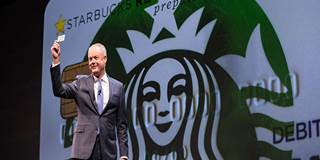How did an international chain of coffee shops position itself to play a major role in upending not just how payments are made but also the business model of established financial institutions? In a word: technology.
WASHINGTON, DC – On August 3, Starbucks made an announcement which, though little noticed at the time, amounts to a potentially massive shift in the organization of finance. How did an international chain of coffee shops position itself to play a major role in upending not just how payments are made but also the business model of established banks?
In a word: technology. The financial system is full of legacy costs and inefficiencies, and the incumbent major banks are generally happy to maintain existing arrangements. But technological advances now make it possible for big tech companies to compete for the profits of the financial sector – if they can find the right partners.
Starbucks matters because it has a strong consumer brand and, in particular, because around 15 million people use the Starbucks Rewards system – which stores value that is typically accessed through an app on people’s phones. Behind that system currently is a credit card, charging significant fees to people who transfer value to Rewards in the Starbucks app. Starbucks, like all merchants, pays those fees, which are not fully transparent to consumers – but which of course add to the cost of a cup of coffee. (Full disclosure: I have the Starbucks app and use it regularly.)

WASHINGTON, DC – On August 3, Starbucks made an announcement which, though little noticed at the time, amounts to a potentially massive shift in the organization of finance. How did an international chain of coffee shops position itself to play a major role in upending not just how payments are made but also the business model of established banks?
In a word: technology. The financial system is full of legacy costs and inefficiencies, and the incumbent major banks are generally happy to maintain existing arrangements. But technological advances now make it possible for big tech companies to compete for the profits of the financial sector – if they can find the right partners.
Starbucks matters because it has a strong consumer brand and, in particular, because around 15 million people use the Starbucks Rewards system – which stores value that is typically accessed through an app on people’s phones. Behind that system currently is a credit card, charging significant fees to people who transfer value to Rewards in the Starbucks app. Starbucks, like all merchants, pays those fees, which are not fully transparent to consumers – but which of course add to the cost of a cup of coffee. (Full disclosure: I have the Starbucks app and use it regularly.)